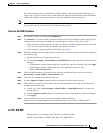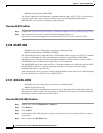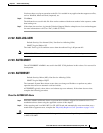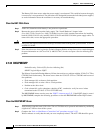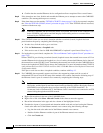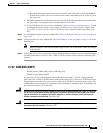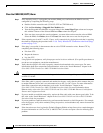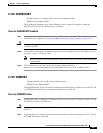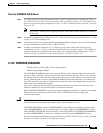
2-33
Cisco ONS 15310-CL and Cisco ONS 15310-MA Troubleshooting Guide, R7.0
Chapter 2 Alarm Troubleshooting
2.7.35 BLSROSYNC
Step 3 If the 15310-CL-CTX or CTX2500 card does not reboot successfully, or the alarm has not cleared, call
Cisco TAC (1-800-553-2447).
2.7.35 BLSROSYNC
The BLSROSYNC alarm is not used in the ONS 15310 platforms in this release. It is reserved for
development.
2.7.36 CARLOSS (CE100T)
Default Severity: Major (MJ), Service-Affecting (SA)
SONET Logical Object: CE100T
The Carrier Loss alarm is raised on CE-Series cards in Mapper mode when the port is In-Service (IS) state
and if there is no carrier signal. Circuit need not be present to raise the alarm. In releases prior to 6.01 the
Carrier Loss alarm is raised on CE-100T-8 cards in Mapper mode when there is a circuit failure due to link
integrity. It does not get raised when a user simply puts the port in the In-Service and Normal (IS-NR) service
state.
lear the CARLOSS (CE100T) Alarm
Step 1 Verify that the fiber cable is properly connected and attached to the correct port. For more information
about fiber connections and terminations, refer to the “Install Hardware” chapter in the
Cisco ONS 15310-CL and Cisco ONS 15310-MA Procedure Guide.
Caution Always use the supplied electrostatic discharge wristband when working with a powered ONS 15310-CL
or ONS 15310-MA.
Step 2 If the fiber cable is correctly connected and attached, verify that the cable connects the card to another
Ethernet device.
Step 3 Verify that the attached transmitting Ethernet device is operational. If not, troubleshoot the device.
Step 4 Verify that optical receive levels are within the normal range. The correct specifications are listed in the
“Install Hardware” chapter in the Cisco ONS 15310-CL and Cisco ONS 15310-MA Procedure Guide.
Step 5 If the alarm does not clear, use an Ethernet test set to determine whether a valid signal is coming into
the Ethernet port. For specific procedures to use the test set equipment, consult the manufacturer.
Step 6 If a valid Ethernet signal is not present and the transmitting device is operational, replace the fiber cable
connecting the transmitting device to the Ethernet port. To do this, refer to the “Install Hardware”
chapter in the Cisco ONS 15310-CL and Cisco ONS 15310-MA Procedure Guide for procedures.
Step 7 If the alarm does not clear, and link autonegotiation is enabled on the port but the autonegotiation process
fails, the card turns off its transmitter laser and reports a CARLOSS alarm. If link autonegotiation has
been enabled for the port, determine whether there are conditions that could cause autonegotiation to fail
by completing the following steps:
a. Confirm that the attached Ethernet device has autonegotiation enabled and is configured for
compatibility with the asymmetric flow control on the card.



